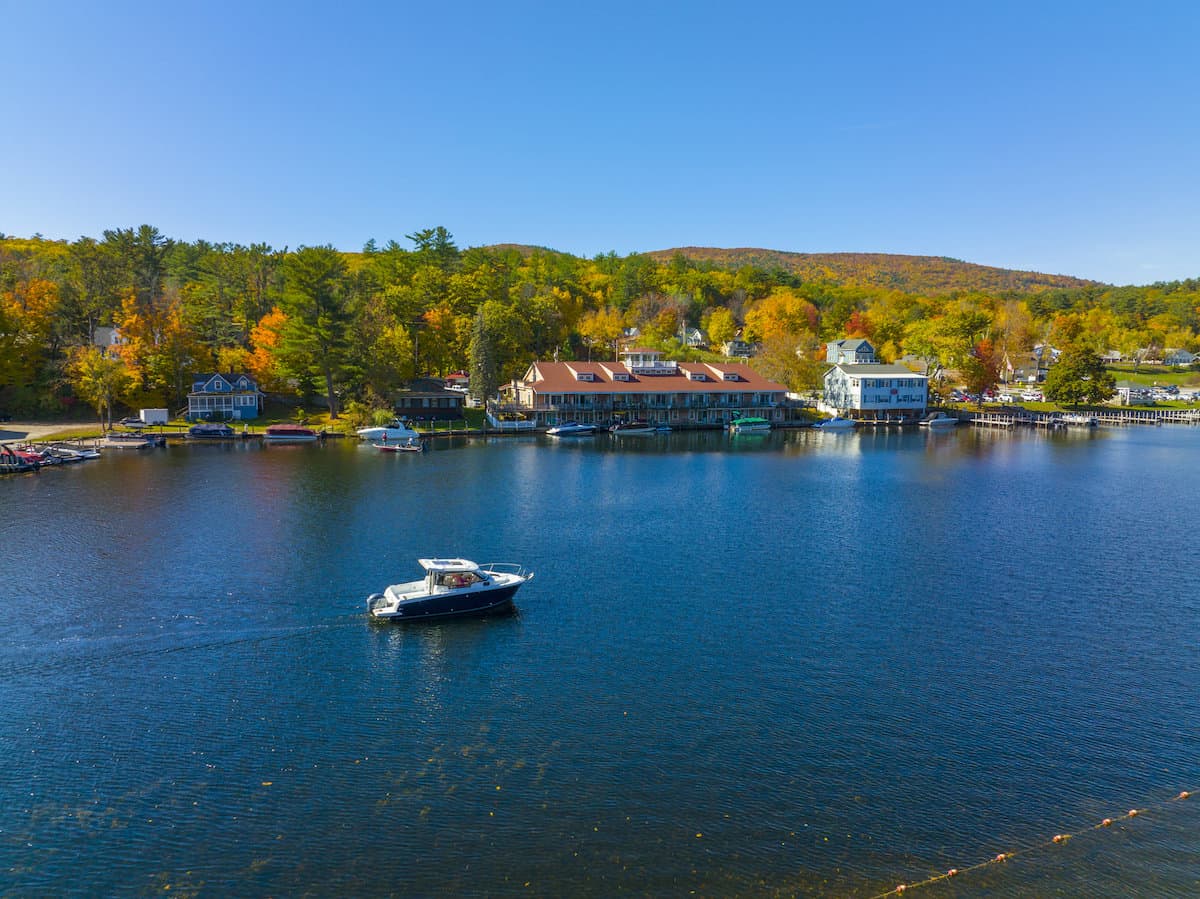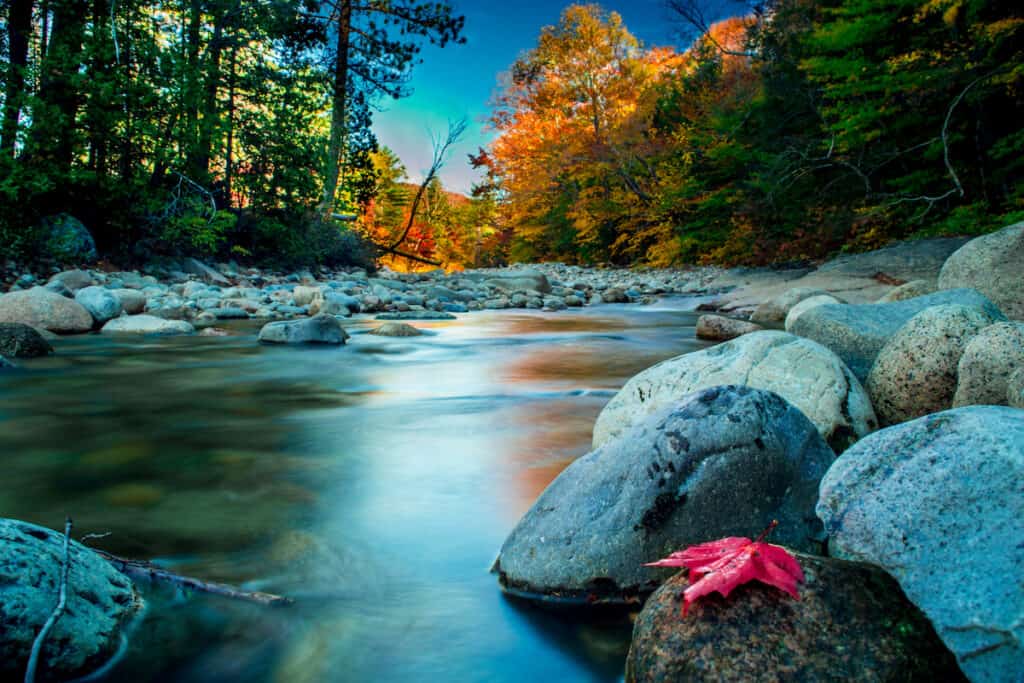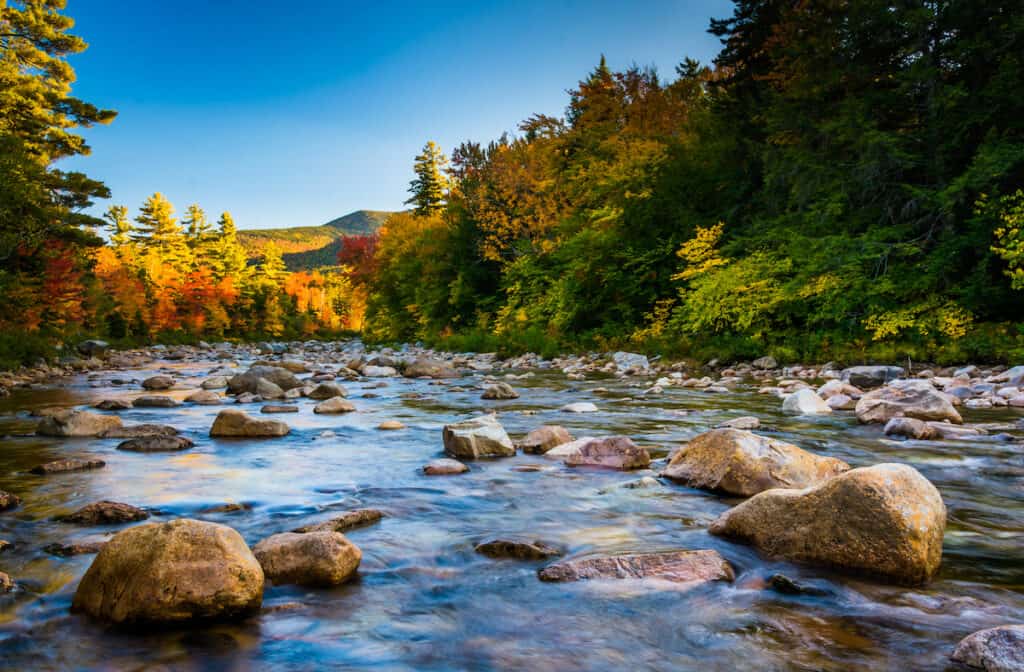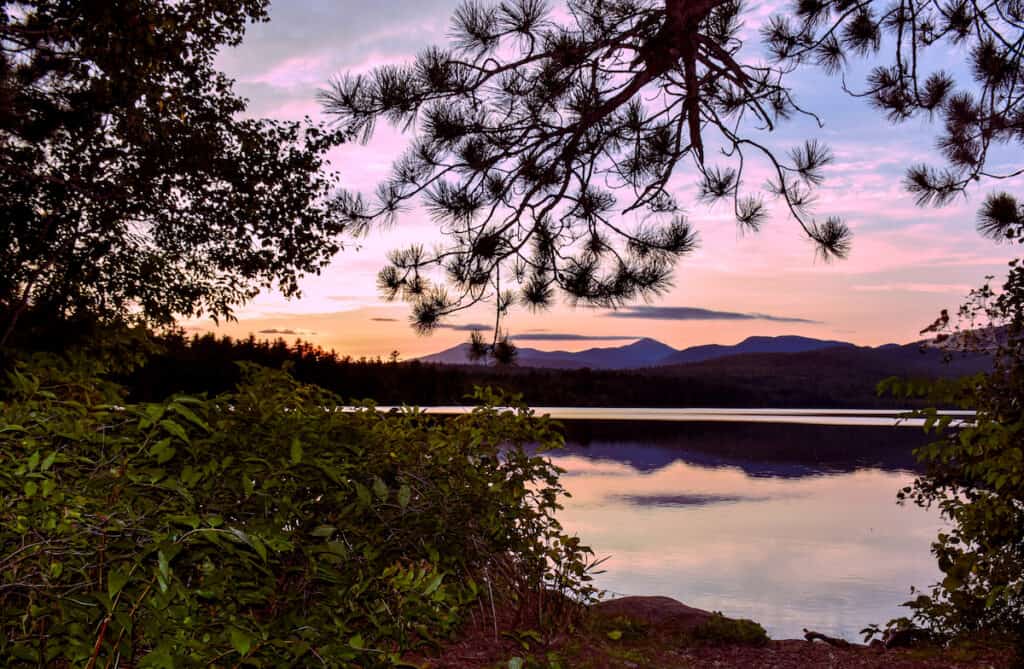New Hampshire prides itself as a state on being the “Mother of Rivers.” The Connecticut River, the Merrimack River, the Androscoggin River, the Saco River and the Piscataqua River are some of New England’s most heralded fisheries.
And they have one thing in common: New Hampshire birthed them all.
In many respects, with quaint towns, scenic mountainscapes, and more than 1,000 lakes, New Hampshire is a fisherman’s paradise.
Among the most popular quarries here are trout. This article shows you more than a dozen of New Hampshire’s top rivers and lakes to catch brown, rainbow, brook and lake trout.
New Hampshire’s Best Trout Streams
Piscataquog River
The section of the Piscataquog that flows from Lyndenboro Road in Lyndenboro to New Boston is managed as a trophy trout section by New Hampshire Fish and Game, meaning they’re trying to protect this particular section of river for the larger-than-average brown and brook trout it’s capable of producing.
The river has rainbow trout, too, many hiding in stretches of the stream that are stunningly scenic and easily wadeable in low-water conditions.
The river is one of the most popular landlocked Atlantic salmon rivers in the state, but the trout fishing can be phenomenal too.
The Piscaquog has primarily a cobblestone riverbed along with some steep drops, so take care wading.
Access: Near the intersection of Old Coach Road and Town Farm Road in New Boston, the Woodland Associates Forest provides access to protected state land that runs along the river.
Connecticut River
Many of New England’s great trout waters have their origins in mountainous New Hampshire.
The Connecticut River begins in Fourth Connecticut Lake, near the United States/Canada border, then flows through Third, Second and First Connecticut lakes along the Vermont border before eventually flowing down through Massachusetts and Connecticut on its southward path to the Atlantic.
The tailwater below Murphy Dam in Pittsburg is a particular favorite stretch for New Hampshire trout anglers. There are brown trout pushing to 10 pounds in this stretch, plus some strapping rainbows and stocked brook trout as well. The state record brown, topping 16 pounds, came from the river.
There are a series of regulations governing particular stretches of the river, some of which are fly-fishing only, some of which mandate the use of a single, barbless hook, but you should read the specifics here.
Access: Lake Francis State Park in Pittsburg provides anglers with parking and riverfront access.
Merrimack River
The Merrimack River, which begins at the confluence of the Pemigewasset and Winnipesaukee rivers, is one of New England’s most diverse river systems.
From trout in the headwaters to smallmouth bass to stripers near the sea, there’s a bit of everything depending on where you fish it.
Trout anglers will want to concentrate on the upper river closer to Franklin, where the two aforementioned rivers join to form the Merrimack.
If you’re fly fishing for trout on the Merrimack, your best bet is to head to Sewall’s Falls Beach Road in Sewalls Falls, which has public access including a trail. The state stocks both rainbow and brook trout here every year.
The river is surrounded on both sides by heavily wooded stretches and is a visually stunning place to fish.
Streamers like wooly buggers are a great option for fly fishing, and small spoons and spinners will take both rainbows and brook trout for spin anglers.
Access: Sewall’s Falls Multi-Use Recreation Area provides both a public park and trail that run along the river for angler access.
The Knights Hill Nature Park runs along the river’s edge in Concord, and the Merrimack breaks off and flows around the park before reconnecting to itself, so you can fish the river on both sides there.
Androscoggin River
The Androscoggin, which flows out of Lake Umbagog along the eastern state line, is a popular New Hampshire river because you’ve got shots at rainbow, brown, and brook trout as well as landlocked Atlantic salmon.
There are both stocked and wild brown trout and good numbers of wild and stocked rainbow trout as well in the upper Andro.
Although the river varies along its path in depth and speed, there are portions that are friendly to wading anglers. Hogan Road in Gorham runs along a stretch of the river that is more popular with wading anglers, whereas other portions are better accessed by drift boat.
May and June and again in September and October are the prime trout fishing months, as the water levels drop and warm significantly in the mid-summer months.
One of the most legendary hatches on the Androscoggin is the alderfly hatch. The ‘alderfly,’ is actually a zebra caddis known to hide underneath the flowers on an alder tree. The hatch typically occurs in late June.
It’s worth noting that the first stretch of the river flowing out of Umbagog, in the town of Errol, is fly-fishing only. Farther down, in Dummer, there is no closed season for any species save for salmon.
From the Sawmill Dam in Berlin to the Maine/New Hampshire border, you must use a single, barbless hook with any lure or fly and release everything that you catch.
Panther Martins are a classic trout lure., The company makes a pack with single hooks rather than trebles found on many commercial lures, allowing anglers to abide by regulations like those in place on stretches of this river. Otherwise, be sure to switch out your lure hooks.
For dozens of miles after crossing the border, the Androscoggin also is on our list of the best trout fishing streams in Maine.
Access: There is a state-maintained Steamer Diamond Boat Launch off Dam Road in Errol, and wading anglers will find that Berlin Road (Rte. 16) follows the river fairly closely through the towns of Errol, Dummer, Milan and Berlin.
Baker River
The Baker River has a west branch that begins near Mount Moosilouke, combining with the east branch northeast of Warren to form the main stem of the Baker.
This river flows right past a fish hatchery in Warren, so you can be confident the Baker is getting its share of those freshly stocked trout.
The Baker River produces healthy catches of rainbow trout, brown trout and brook trout every year. Records show thousands of brook trout, including a handful of larger ones, tend to be planted.
The best fishing will always be in the early spring, before the water becomes too warm for these fish to be active. Wooly buggers and other streams as well as small lures and other spoons are all effective methods here.
Also, a Royal Coachman can be a great fly in the late spring and early summer months on the Baker.
Access: The Sawyer Highway (Rte. 118) will lead you to both the Mcvetty Trail system and the Hubbard Brook Trailhead, which run along the Baker River and its east branch, respectively.
Pemigewasset River
The Pemigewasset is a northern New Hampshire river that flows down and feeds the Merrimack in Franklin, as mentioned in the Merrimack section above.
The section of the Pemigewasset from 150 feet below the Eastman Falls Dam in Franklin to where it joins the Winnipesaukee River is stocked and open year-round to trout fishing.
The river passes through beautiful mountain landscapes, like Franconia Notch State Park, where the elevation is nearly 2000 feet above sea level.
The higher elevation and runoff keep the river cooler in the spring and early summer and better enable stocked trout to survive the early warm months of summer. Whitehorse, Cascade, Dry, Flume and Walker brooks all flow into the Pemigewasset to help keep it cool.
Access: Follow Interstate 93 north to exit 28, take a left off the exit and a right onto Owl Street. Follow Owl Street and take a left onto Pemi River Road. About 500 feet north you’ll see a golf cart path where you can park (don’t block the path). You can walk along the path and the state land begins when you walk under Interstate 93.
Woodstock Family Park, right behind the fire department in Woodstock, offers easier river access for those less interested in a scenic hike.
Sugar River
Flowing out of Lake Sunapee and winding for 27 miles before it flows into the Connecticut River, this stream offers some sweet opportunities for New England anglers.
One highlight of the Sugar is it features the Sugar River Trail, which follows along its course between Claremont and Newport, a distance of roughly 7.7 miles. The North and South branches converge in Newport.
The state has stocked the Sugar with brown, rainbow and brook trout liberally in years past, and there are some sizeable holdovers for anglers willing to work.
Access: The Sugar River Recreational Rail Trail begins near the intersection of Old Newport Road and Rte. 11/103 in Claremont and follows the stream.
Swift River
The Swift begins in Livermore and flows into the Saco River in Conway, and has been liberally stocked with brook trout in years past. Some of the stocked trout include larger 2-year-old brookies, and rainbow trout also are stocked.
True to its name, the Swift begins on Mt. Kancamagus and has precipitous elevation drops along its route through the White Mountains to the Saco River, including some beautiful waterfalls.
The Swift River Valley is noted for having populations of black bear, moose, fisher, mink and peregrine falcons, so this is a wild place.
Two spots on the river, Rocky Gorge and Lower Falls, are managed by the U.S. Forest Service as scenic overlooks.
Access: The Champney Falls Trailhead in Albany provides access to a trail that follows along the Swift’s route.
Phillips Brook
The west branch of Phillips Brook flows out of Phillips Pond and then continues for 16 miles until it dumps into the Ammonoosuc River in Stark.
Brook trout are the star of the show here, with the state stocking this stream with more one-year-old fish than any comparable body of water in that region of northern New Hampshire.
The streams branches meet to form the main stem along Phillips Brook Road, about 15 miles northeast of Stark. The brook trout here might not be enormous, but they are plentiful.
If you’re looking for your best shot just at sheer numbers, this is a good place to start in the spring. Pay attention to regulations to note the fly-fishing-only sections of the stream.
Access: Phillips Brook Road in Groveton follows the stream and is a good road to drive looking for promising pull-offs and pools.
New Hampshire’s Best Trout Lakes
Lake Winnipesaukee
Any list of New Hampshire fisheries that doesn’t have one that starts with “Winni” is doing something backward.
Lake Winnipesaukee has a surface area of more than 44,400 acres, more than 300 miles of shoreline, 265 natural islands, and reaches depths of more than 200 feet.
Winni also has one of only two floating post offices left in the United States, but that’s neither here nor there unless you told your spouse you’re just running to mail a letter as an excuse to work in some fishing.
Rainbows and lakers are the most popular trout species, although anglers land a brook trout on the rare occasion.
The state tends to stock Winni with thousands of rainbow trout each year.
To catch them in so much water, trolling will often be your best bet. Mooselook Wobblers are a popular spoon for both rainbows and landlocked Atlantic salmon.
The lake trout typically move into the deepest, coldest parts of the lake during the summer.
Vertical jigging with jigs that resemble rainbow smelt, the predominant forage, is a great option.
Access: The Cattle Landing public docks in Meredith give you good central access to the lake’s north end.
More: Complete Guide to Lake Winnipesaukee Fishing
Mirror Lake
Mirror Lake near Woodstock gets a healthy stocking of brown trout, rainbow trout and brook trout in different age classes every year.
The southeast corner has the steepest drops, although the lake only gets about 12 feet deep.
The north half of the lake is largely a shallow flat, where you might find browns cruising at first and last light or even mid-afternoon on cool spring and fall days.
Often a small stickbait, like a Rapala, fished erratically with twitches and pauses, can entice the biggest browns in a given body of water, especially in the cool fall months when they’re more actively feeding in shallow water.
Access: Mirror Lake Public Beach has a gravel boat launch on the lake’s south side.
Tewksbury Pond
At 47 acres with depths reaching no more than 50 feet, Tewksbury is a beautiful little pond where you’ve got brook trout pushing 15 inches and brown trout as well.
The steepest drops in the pond are along the southeastern edge, toward the center.
Tewksbury has been one of the ponds that the state often stocks both in the spring and the fall in anticipation of the coming ice fishing season, so it has healthy populations of trout to be sure.
Speaking of hard-water angling, Tewksbury is also on our list of best ice-fishing lakes in New Hampshire.
Access: Tewksbury Landing Road is right off Rte. 4/Main Street between Grafton and Canaan.
Webster Lake
Webster Lake in Franklin is a 606-acre body of water that has gotten some of the most robust trout-stocking efforts from the state in recent years.
Brown trout are stocked in multiple age classes, with anglers catching some arm-length fish here.
The deepest hole reaches more than 30 feet on the pond’s southern end, in the lower third of the lake.
Access: There is a boat launch off Webster Lake Road in Franklin.
Success Pond
This one is a no-brainer, right? The state recently purchased property here, in the town of the same name, and has stocked the lake with rainbow trout, brown trout and brook trout.
The bowl-shaped pond never gets deeper than 30 feet, meaning the healthy numbers of stocked fish don’t have a ton of water to hide in.
If you’re heading South on Success Pond Road, make note when you pass Four Corners Road to watch your odometer. In about two-tenths of a mile, you’ll come to a stretch of shoreline that’s got the pond’s deepest near-shore drop.
Within casting range, the pond drops off to 15 feet deep. This would be a prime ambush area for both brown and rainbow trout, especially in low-light conditions.
Access: Boat Ramp Drive off of West Side Drive on the pond’s south end features a public launch.
Catch More Trout
Check out our general guide to trout fishing, including techniques, tips and tackle ideas.




